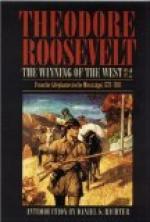regulars. Thus Haywood says that after the battle
of the Island Flats, the whites were so encouraged
that thenceforward they never asked concerning their
enemies, “how many are they?” but “where
are they?” Of course, this is a mere piece of
barbaric boasting. If the whites had really acted
on any such theory there would have been a constant
succession of disasters like that at the Blue Licks.
Sevier’s latest biographer, Mr. Kirke, in the
“Rear-guard of the Revolution,” goes far
beyond even the old writers. For instance, on
p. 141 he speaks of Sevier’s victories being
“often” gained over “twenty times
his own number” of Indians. As a matter
of fact, one of the proofs of Sevier’s skill
as a commander is that he almost always fought with
the advantage of numbers on his side. Not a single
instance can be produced where either he or any one
else during his lifetime gained a victory over twenty
times his number of Indians, unless the sieges are
counted. It is necessary to keep in mind the
limitations under which Haywood did his work, in order
to write truthfully; but a debt of gratitude will always
be due him for the history he wrote. Like Marshall’s,
it is the book of one who himself knew the pioneers,
and it has preserved very much of value which would
otherwise have been lost. The same holds true
of Ramsey.] He could then outflank or partially surround
the Indians, while his sudden rush demoralized them;
so that, in striking contrast to most other Indian
fighters, he inflicted a far greater loss than he received.
He never fought a big pitched battle, but, by incessantly
harrying and scattering the different war bands, he
struck such terror to the hearts of the Indians that
he again and again, in a succession of wars, forced
them into truces, and for the moment freed the settlements
from their ravages. He was almost the only commander
on the frontier who ever brought an Indian war, of
whatever length, to an end, doing a good deal of damage
to his foes and suffering very little himself.
Still, he never struck a crushing blow, nor conquered
a permanent peace. He never did any thing to
equal Clark’s campaigns in the Illinois and against
Vincennes, and, of course, he cannot for a moment be
compared to his rival and successor, grim Old Hickory,
the destroyer of the Creeks and the hero of New Orleans.
Sevier’s Cherokee Campaigns.
When the men of the Holston or upper Tennessee valley settlements reached their homes after the King’s Mountain expedition, they found them menaced by the Cherokees. Congress had endeavored in vain to persuade the chiefs of this tribe to make a treaty of peace, or at least to remain neutral. The efforts of the British agents to embroil them with the whites were completely successful; and in November the Otari or Overhill warriors began making inroads along the frontier. They did not attack in large bands. A constant succession of small parties moved swiftly through the county, burning cabins,




